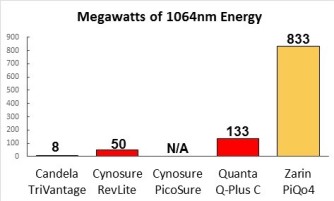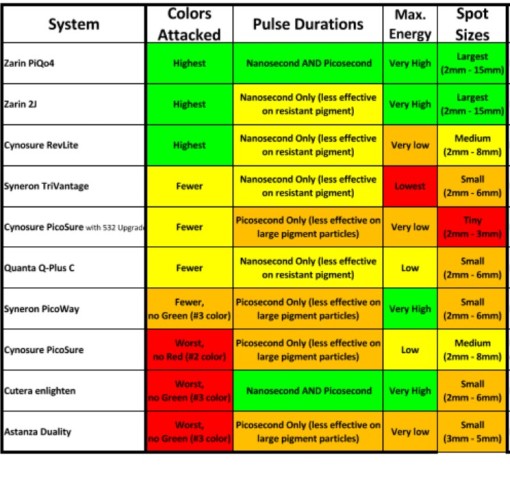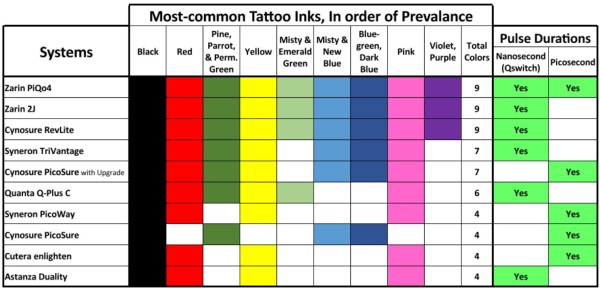
Tattoo removal is most effectively performed with lasers. The mechanism by which the laser works is by breaking up the larger ink granules into smaller particles. The body is unable to clear the larger particles but when smaller, the immune system is capable of clearing the ink. Successful clearance of a tattoo is dependent on several factors which will be highlighted in the remainder of the blog. While the experience of the physician performing the tattoo removal can’t be ignored, he/she is limited by the laser being used.
There are 3 aspects that need to be considered in a tattoo laser. They are power (and spot size), wavelengths, and pulse durations.
Power
Power is a measure of how much energy can be delivered to the skin. What’s more important is how much is getting to the level of tattoo. It remains obvious, the more power delivered to a tattoo, the better clearance there should be. This is limited by the damage to the skin and surrounding soft tissue. Excessive energy to the superficial skin can lead to blistering, prolonged healing, scarring, and pigmentation changes. High-power lasers are able to use large spot sizes (10-15mm) to deliver the energy to the tattoo. Larger spot sizes give deeper penetration of energy and a safer treatment. Under-powered lasers need smaller spot sizes to get enough energy into the skin to cause an effect on the tattoo. This leads to the superficial skin heating up and potential for blistering/scarring.

When comparing energies between lasers, most companies measure the output from the laser. What is not discussed is how much the energy is diminished while going through the arms, mirrors, and handpiece. This can account for 20-30% less energy at the skin than what is the measured output of the laser in the lab. (The energy measured by the Piqo4 system is to the skin while all other systems is output from laser.)


Wavelength
The wavelength of a tattoo laser determines what colors it can treat. The most common color in tattoos is black. The best wavelength for treating black inks is 1064nm. This wavelength also is the safest for darker skin type. Even if the tattoo doesn’t look like it has black ink, over 95% have some component of black ink. It is imperative that the laser chosen for tattoo removal has a 1064 wavelength. The next most common ink is red. This is best treated with a 532 wavelength. Almost always, the 532 and 1064 wavelengths are packaged together in the same laser. It requires a doubling of the frequency to go from 1064 to 532 (double frequency means halving wavelength). The remaining colors require a variety of wavelengths so it is essential to have multiple wavelengths to treat colored tattoos. The lighter the color – pink, yellow, white, light blue – the harder it is to treat.

Pulse Duration
The lasers for tattoo removal are much faster than lasers used for hair removal, photofacials, telangiectasias, and leg veins. Where as the typical pulse duration is measured in milliseconds for the dermal treatments, tattoo lasers are measured in either nanoseconds or picoseconds (1000x – 1,000,000x). These extremely short pulses lead to extremely high energies being placed into the tattoo. This energy leads to a shock wave hitting the ink and breaking it up. The faster the pulse, the higher the energy and the more directed the energy is to the ink and less to the surrounding tissues. The longer the pulse, the more time the energy has to spread to the tissues. In the author’s opinion, initial treatments for tattoos are best performed with nanosecond pulses (to break up the larger ink particles) while the later treatments need picosecond pulses to clear the remaining ink particles which are smaller in size. It is most effective to have a laser with both nano and picosecond capabilities for treating tattoos.
The Best Laser for Tattoo Removal
After understanding the important qualities required in a laser for optimal treatment of a tattoo, it becomes fairly easy to see the obvious best laser. The Piqo4 has the highest energy (to the skin) of all nano/picosecond lasers. As a corollary, it has the largest spot sizes on the market – meaning safer, deeper, and faster treatments. With it’s 4 wavelengths, it has the capabilities to treat the 9 most common colors. It has 4 different pulse durations – 2 and 8 nanosecond and 600 and 800 picosecond. In conclusion, the Piqo4 combines high power, 4 wavelengths, and multiple pulse durations to enable it’s lasers to be the most effective option available on the market.
we’d love to meet you
Schedule a consultation
Are you ready to take the first step towards achieving your goals? Book Now or Contact Us first with any questions today!
Have a Question?




